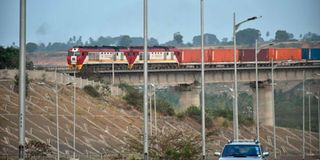Traders still prefer SGR to move goods despite order

A cargo train leaves for Nairobi via Mombasa's Southern Bypass on February 12, 2021.
Traders have continued to use trains to transport their cargo from Mombasa to Nairobi, despite a government directive reverting some port services to Mombasa.
According to the latest report by the Kenya National Bureau of Statistics (KNBS), rail freight services maintained an upward trend in the last quarter of last year.
Cargo hauled on the standard gauge railway (SGR) increased from 5.41 million metric tonnes in 2021 to 6.01 million metric tonnes last year, the data shows.
In terms of revenue, SGR freight services continued to support passenger services by generating Sh12.67 billion last year compared to Sh12.17 billion in the previous year.
The Kenya Railway Corporation (KRC) in December 2021 gazetted promotional tariffs to ferry cargo from the Mombasa port to Malaba at Sh101,419 for a 20-foot container weighing up to 30 tonnes, and Sh113,212 for a container weighing above 30 tonnes.
Charges on a 40-foot container weighing up to 30 tonnes stood at Sh130,902 while those above 30 tonnes were levied Sh148,591.
Passenger traffic between Nairobi and Mombasa was 2.39 million people in 2022, generating Sh2.6 billion in revenue compared to 1.99 million in 2021. Trains have become a popular means of transport for Kenyans due their reliability, affordability and speed compared to buses.
Mr Abdi Awale, a Mombasa-based transporter whose more than 20 trucks have been lying idle for years, said more use of the SGR to ferry cargo is also welcome news to him because he is also getting good business.
“We are not complaining since we get our share of port cargo as we have an advantage to drop cargo to our client’s doorstep and in areas where SGR freight service does not reach,” said Mr Abdi. The Kenya Ports Authority (KPA) recently issued a directive to shipping lines to allow nomination of cargo in Mombasa after a four-year ban.
“Before revocation of compulsory usage of SGR to ferry cargo to Nairobi, I was forced to park my trucks as we did not have business. All cargo was being nominated to be cleared in Nairobi and Naivasha and to be hauled byvia trains,” he added.
Nation yesterday established that most of the traders had already shifted to Nairobi and the announcement to return services to Mombasa could not affect SGR volumes.
“I have a long term contract with Kenya Railways and I cannot cancel it. With the adoption of technology and paperless cargo processing by KPA, I have no intention to cancel my contract on using rail,” said Mr Joseph Karanja, a Nairobi-based businessman.
A spot check by Nation at the port yesterday revealed that, over six months after the directive to return port services from Naivasha and Nairobi to Mombasa, most clearing and forwarding companies that had closed shop have not reopened and many have turned to technology to transact.
KPA Managing Director William Ruto said at least 2,000 trucks pick up cargo at the port of Mombasa every day.
“There is an increase of cargo volumes through Mombasa port and each mode of transport gets its share of cargo, which helps in ensuring there is no congestion at the facility,”Mr Ruto said.
In the KNBS report, total monthly throughput at the port of Mombasa dropped from 2.7 million metric tonnes in November 2022 to 2.5 million metric tonnes in December 2022.





